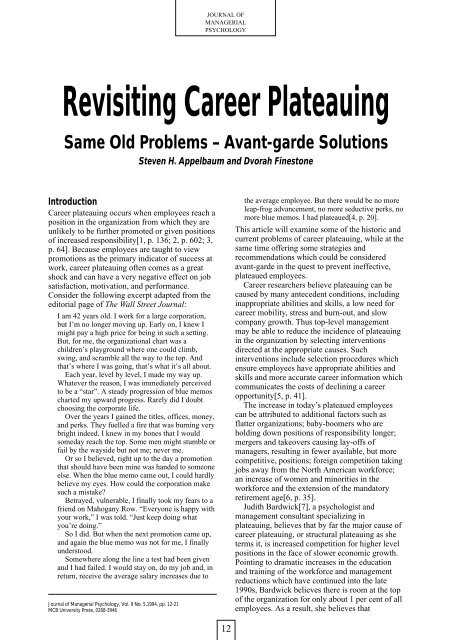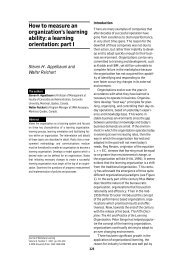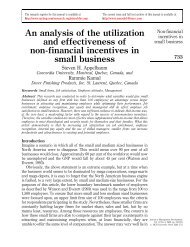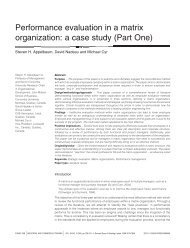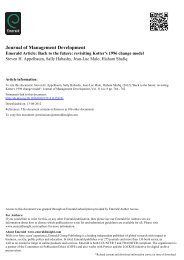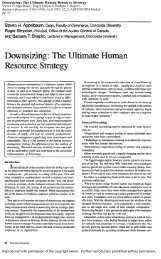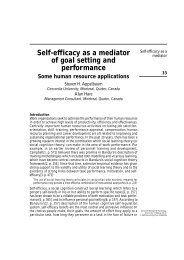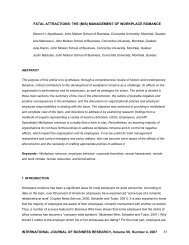Revisiting Career Plateauing - Dr. Steven H. Appelbaum Consultants
Revisiting Career Plateauing - Dr. Steven H. Appelbaum Consultants
Revisiting Career Plateauing - Dr. Steven H. Appelbaum Consultants
Create successful ePaper yourself
Turn your PDF publications into a flip-book with our unique Google optimized e-Paper software.
JOURNAL OFMANAGERIALPSYCHOLOGY<strong>Revisiting</strong> <strong>Career</strong> <strong>Plateauing</strong>Same Old Problems – Avant-garde Solutions<strong>Steven</strong> H. <strong>Appelbaum</strong> and Dvorah FinestoneIntroduction<strong>Career</strong> plateauing occurs when employees reach aposition in the organization from which they areunlikely to be further promoted or given positionsof increased responsibility[1, p. 136; 2, p. 602; 3,p. 64]. Because employees are taught to viewpromotions as the primary indicator of success atwork, career plateauing often comes as a greatshock and can have a very negative effect on jobsatisfaction, motivation, and performance.Consider the following excerpt adapted from theeditorial page of The Wall Street Journal:I am 42 years old. I work for a large corporation,but I’m no longer moving up. Early on, I knew Imight pay a high price for being in such a setting.But, for me, the organizational chart was achildren’s playground where one could climb,swing, and scramble all the way to the top. Andthat’s where I was going, that’s what it’s all about.Each year, level by level, I made my way up.Whatever the reason, I was immediately perceivedto be a “star”. A steady progression of blue memoscharted my upward progress. Rarely did I doubtchoosing the corporate life.Over the years I gained the titles, offices, money,and perks. They fuelled a fire that was burning verybright indeed. I knew in my bones that I wouldsomeday reach the top. Some men might stumble orfail by the wayside but not me; never me.Or so I believed, right up to the day a promotionthat should have been mine was handed to someoneelse. When the blue memo came out, I could hardlybelieve my eyes. How could the corporation makesuch a mistake?Betrayed, vulnerable, I finally took my fears to afriend on Mahogany Row. “Everyone is happy withyour work,” I was told. “Just keep doing whatyou’re doing.”So I did. But when the next promotion came up,and again the blue memo was not for me, I finallyunderstood.Somewhere along the line a test had been givenand I had failed. I would stay on, do my job and, inreturn, receive the average salary increases due toJournal of Managerial Psychology, Vol. 9 No. 5,1994, pp. 12-21MCB University Press, 0268-3946the average employee. But there would be no moreleap-frog advancement, no more seductive perks, nomore blue memos. I had plateaued[4, p. 20].This article will examine some of the historic andcurrent problems of career plateauing, while at thesame time offering some strategies andrecommendations which could be consideredavant-garde in the quest to prevent ineffective,plateaued employees.<strong>Career</strong> researchers believe plateauing can becaused by many antecedent conditions, includinginappropriate abilities and skills, a low need forcareer mobility, stress and burn-out, and slowcompany growth. Thus top-level managementmay be able to reduce the incidence of plateauingin the organization by selecting interventionsdirected at the appropriate causes. Suchinterventions include selection procedures whichensure employees have appropriate abilities andskills and more accurate career information whichcommunicates the costs of declining a careeropportunity[5, p. 41].The increase in today’s plateaued employeescan be attributed to additional factors such asflatter organizations; baby-boomers who areholding down positions of responsibility longer;mergers and takeovers causing lay-offs ofmanagers, resulting in fewer available, but morecompetitive, positions; foreign competition takingjobs away from the North American workforce;an increase of women and minorities in theworkforce and the extension of the mandatoryretirement age[6, p. 35].Judith Bardwick[7], a psychologist andmanagement consultant specializing inplateauing, believes that by far the major cause ofcareer plateauing, or structural plateauing as sheterms it, is increased competition for higher levelpositions in the face of slower economic growth.Pointing to dramatic increases in the educationand training of the workforce and managementreductions which have continued into the late1990s, Bardwick believes there is room at the topof the organization for only about 1 per cent of allemployees. As a result, she believes that12
VOLUME 9 NUMBER 51994plateauing is now so widespread as to beconsidered a normal career development stageand that this trend will continue.Unfortunately, the phrase career plateau has anegative connotation of failure and defeat. Aplateau describes an individual’s current careerstatus within a particular organization and doesnot necessarily imply cessation of personalgrowth and career development. Plateaux may becategorized in two ways: organizational plateauxand personal plateaux. People who areorganizationally plateaued may have the ability toperform well in higher level jobs but are unable todo so owing to the lack of job openings and/or amanagement belief that he/she lacks the requiredskills. Age may also be a consideration if theorganization decides to hire younger employeeswho are assumed to lead longer useful lives.Actuarial data do not support these hypothesesproffered by managerial professionals.Personally plateaued people are seen by theorganization as not desiring a higher level job.The individuals may be lacking in professional ortechnical skills and/or are organizationally naïveand side-tracked too long in their present job.Others may simply not want to be promoted anyfurther even though they have the ability[2, p.605].Assuming the incidence of career plateauingwill occur more frequently in the future, it isimportant for organizations to determine whatmay be done to reduce its negative impact onemployees. As Bardwick notes, ambition maybecome an organizational liability if careerplateauing yields extreme frustration, low workinvolvement, dissatisfaction, and poorperformance[7, p. 60].Life-cycle Theories of <strong>Plateauing</strong> andSuccessionAn examination of the literature and researchdealing with career plateauing has led to somerelationships which may exist betweenorganization succession planning, downsizing,and the problem of plateauing, in particular whenthese inextricably interwoven concepts arecontrasted via life-cycle theories. There are fourmanagerial career states which are founded on thetwo parameters of succession planning: currentperformance and future potential or the likelihoodof future promotions.The four states of managerial careers arelearners or comers, stars, solid citizens and deadwood.Learners have high potential foradvancement but are performing below standard.Examples include trainees still learning their newjob and not yet immersed into the organization aswell as employees recently promoted to newpositions. Stars are on “the fast track” career path,doing outstanding work and viewed as havinghigh potential for continued advancement. Solidcitizens do satisfactory work, yet are perceived ashaving little chance for future advancement.Dead-wood individuals do unsatisfactory workand have little potential for advancement. Thesolid citizens and the dead-wood are the plateauedmanagers. The difference between the two is thatsolid citizens are effective plateaux, while thedead-wood are ineffective plateaux[2, p. 603].nIndividuals enteran organization aslearnersnThe model can also be viewed as a description ofhow careers progress over time. According to thelife-cycle view of careers, individuals enter anorganization as learners. As they master the job,they become stars and candidates for promotion.Sustained performance moves them between thelearner and star categories. Eventually, they dropout of competition for the next promotion andmove on to the inevitable career plateau andbecome solid citizens. Then age, lack ofchallenge, lack of motivation or lack of attentionsets in and individuals become dead-wood[2, p.607]. This description is not universal but occursin enough instances to be a virtually predictablephenomenon of careers.Lundberg[8, p. 291] addresses this issue bysuggesting that we give attention to theorganizational life-cycle in order to understandhow and why succession occurs or why it doesnot lead to a plateaued employee. According tothe research this approach provides a new way oflooking at an organization in a dynamic contextwhich initiates changes and “transitional” phases.As the organization moves through its life-cycle ittransforms itself to meet the demands of itsenvironment. Basically, this means thatorganizations must constantly adapt themselves totheir environment. When this adaptation processis insufficient to ensure the best fit between theorganization and its environment, then a majorshift in strategy is required to correct thesituation. This transformation process is oftentranslated into cultural and strategic changeswhich trigger executive change and career shift asthe ultimate step which may be required to allow13
JOURNAL OFMANAGERIALPSYCHOLOGYthe organization to adjust itself to the newenvironmental context.This process of succession can happen duringany one of the organization’s development stages,namely: birth and early growth, organization midlifeand organizational maturity and stagnation.This is quite congruent with the four career statesjust discussed. Once this identification process isfulfilled, another issue is to determine the bestavailable candidates who can assume the keypositions. As the organization moves through itsdevelopment stages specific and different skillsare required from candidates to ensure thesuccessful implementation of the strategy. Forexample, within the birth and early growth stagesthe successor requires skills which will enableher/him to develop a vision consistent with theorganization’s founders, build on theorganization’s strengths with a viable strategy andknow how to communicate it to all levels ofmanagement. He/she also requires the skills tomotivate individuals to work together inachieving the organizational objectives and createan atmosphere of security. During the mid-lifestage, the successor requires other skills whichwill enable him/her to pursue growth whilemaintaining the organization as a whole. She/hemust also continue communicating the culture ofthe corporation to stimulate among individuals asense of belonging and sharing the samecorporate values. In the maturity/stagnation stagesof the organization the successor requires skillswhich will guide the organization to focusinwardly and take the required action to cut costand control key resources. It is at these varyingpoints where individuals may plateau eitherorganizationally or personally if a fit betweentheir skills and new job demands is incongruous.In some of these instances organizations engagein reduction activities, such as downsizing, in thequest to ameliorate what they perceive to be aproblem in need of a quick-fix solution.However, downsizing can be an alternative; ifsuch is the case the successor will need to knowhow to keep morale high and motivate individualsto continue to perform. He/she also must findways to stimulate innovation and encourageprojects to develop new products during thisperiod. It is important to understand downsizingas the systematic reduction of a workforce by anemployer in a variety of ways, usually as a resultof such developments as financial losses,cashflow difficulties, and technological changes.Techniques used include hiring freezes, earlyretirement, transfers, and terminations[9, p. 68].In this case succession planning, downsizing andcareer plateauing share a symbiotic relationship.However, downsizing has become popularizedas a potential outcome of plateauing. Unfortunatelyit is not a panacea. Not all cases are deemedsuccessful. Why do some companies suffer fromlower morale and productivity after downsizing,while others actually enjoy higher performancelevels and greater job satisfaction? The answerlies, in large part, in the careful, strategic planningand skilful implementation of the downsizingprogramme, headed by an involved, aware humanresources management team. Because thecompany’s success, and even its survival, dependon the success of the plan, designing andimplementing the programme may indeed becalled the tough test of downsizing[9, p. 69].nDetermine if the successionevent is anticipatedor notnDuring each stage, the successor must take intoaccount the possibilities of making the neededchanges and creating the fit between strategy andthe environment. By identifying at which stage ofthe life-cycle succession occurs, the organizationcan determine which successor has the capabilityto perform the role required of her/him accordingto the stage. This proper fit may close the gap forindividuals who plateau prematurely. Anotherissue is to determine if the succession event isanticipated or not. If so, then the organization is ina better position to identify the potentialsuccessors as well as those who are about toplateau. This will yield the time needed toidentify/articulate the required mechanisms whichwill enable it to develop the successors’competences. It is suggested that thisdevelopment be focused on providing theindividuals with a wide range of skills which willenable them to adjust to, as well as implement,change or “transition” at different stages of theorganization’s life-cycle. Finally, the issue of whoshould be involved in the succession processrequires that the organization assigns a key groupof individuals to co-ordinate the process. In mostorganizations the human resources departmentmust be actively involved in this process. Theorganization and key management must alsodetermine the level of involvement ofmanagement. These individuals must participatein the selection of the successor, and in theplanning of the selection process. This can beaccomplished by searching for potential14
VOLUME 9 NUMBER 51994candidates from whom the successor will bechosen. Finally, they must ensure the properdevelopment of the successor and monitor his/herapprenticeship with regard to corporate valuesand culture. This requires that a successionsystem be implemented with specific goals toattract and retain, as well as develop, successorswho possess change and transformation skills andcompetences. The succession system will providethe organization with the tools for assessingexecutive behaviour, selecting executivesuccessors, and developing desirable executivecompetences. Thus attempts to implement asuccession plan with an understanding of thetransitional phases of an organization and its lifecyclewill ensure the best fit between thecorporate strategy and the components of thesuccession system. This may be one of the betterantidotes for the more dysfunctional cases ofplateauing.Many organizations have critical positions tobe used to develop key potential candidates.Unfortunately, when organizations considerdownsizing and related activities it becomesimpossible to maintain these key jobs because ofpossible cut-backs making executive developmentdifficult. However, it is suggested that theorganizations make an effort to create other typesof development assignment experiences such astaskforces or special projects available. Chancesof success are increased when organizationsprovide the individuals with the tools to help themdevelop themselves and reward them withpromotions for their performances whatever theorganizational context[10, p.191]. This is anotherprerequisite for effective career path planning inlieu of plateauing.The career plateau model of Ference et al.[2]addressed several critical issues which linkedsuccession with life-cycle transitions. It isrecommended that management must preventsolid citizens from becoming dead-wood anddifferent managerial approaches are needed forthe different career states. In addition, it must bestressed that negative outcomes are not anautomatic consequence of being plateaued. Aperson who has reached a “terminal” level in anorganization can become a good performer (solidcitizen) or a poor one (dead-wood). Growth andlearning can be maintained when a person hasplateaued. Growth refers to the development andutilization of new skills, abilities and attitudesand, therefore, does not necessarily requirepromotion. However, the problem is thatmanagement usually focuses all attention on highpotential younger employees, neglecting the midcareersolid citizens. The stars and the dead-woodare the people who receive the most attention indevelopment programmes and managerialdiscussions, not the solid citizens[11, p.273].Near[12] performed a study to deal with somecommon assumptions people have aboutplateaued employees. For example, theseemployees are assumed to have lower jobperformance, lower motivation and satisfaction,lower aspiration, bad attitudes and behaviour innon-work factors, and lower ratings of their ownjob[13, p. 33]. This study found that plateauedmanagers worked fewer hours and had higherabsenteeism than non-plateaued employees. Yet,it also found plateaued employees were neitherless motivated nor less satisfied than their nonplateauedpeers. In addition, they did not havepoorer attitudes or work behaviours. They did,however, rate their jobs as less challenging andless rewarding, and reported much lower careeraspirations.nA large percentageof plateaued managers claimedto be very happynIn another study based on interviews with 200managers from various firms, Near found both theplateaued managers and the non-plateauedmanagers described their jobs in similar waysregarding the difficulty, challenge, time pressures,and benefits[12, p. 75]. Other resultsdemonstrated the plateaued managers were aslikely as the non-plateaued managers to ratefavourably their relations with co-workers, yetwere much more likely to rate negatively theirrelations with supervisors. When asked how theysaw themselves at work, virtually equal numbersof plateaued and non-plateaued managers felt theywere highly successful, knowledgeable about thejob, and motivated to do their best on the job.Furthermore, the plateaued managers’ satisfactionoff the job was nearly as high as that of their nonplateauedmanagers. A large percentage ofplateaued managers claimed to be very happywith their current position[14, p. 77].Based on these results, it was concluded thatmost managers cope with and adapt to the careerplateau without too much difficulty. Yet, differentcoping mechanisms are used. For example, somemanagers avoid facing up to the true implicationsof the plateau by emphasizing the negativefeatures of a promotion such as longer hours,increased pressure and greater responsibility.15
JOURNAL OFMANAGERIALPSYCHOLOGYThen, when the plateau is reached, they are happywith their current position. Others compensate forthe disappointment of the plateau by putting theirenergies into activities outside the job, whichprovide a needed outlet[12, p. 78]. Others denythe fact, pretending it is only a temporary statewhich will pass with the next management shakeupor increase their efforts, thinking hard workwill pay off in the end[12, p. 56].The following section of this article willexamine the relationship between careerplateauing and performance; career plateauingand mobility; and career plateauing with businessstrategies.<strong>Plateauing</strong> and PerformanceCarnazza et al.[15, p. 8] investigated whether acareer plateau affects performance positively ornegatively. They conducted a Managerial <strong>Career</strong>Survey with 449 middle- and upper-levelmanagers and their immediate superiors of anindustrial firm based in the north-eastern states ofthe USA. The questionnaire was developed toidentify the various experiences, attitudes, beliefsand opinions of experienced managers. Fourgroups were identified: non-plateaued managers(seen by the organization as having a highlikelihood of promotion), plateaued managers(seen by the organization as having a lowlikelihood of promotion), those who sawthemselves as having a high likelihood ofpromotion and those who saw themselves ashaving a low likelihood of promotion. In general,the results demonstrated that the experiences,opinions, attitudes and beliefs associated with jobperformance varied according to the individual’slikelihood of promotion and the congruencebetween individual and organizational estimatesof likelihood of promotion[15, p. 21].More specifically, the study found that threefactors related to the job performance of “highlikelihood of promotion” managers: recognitionof contributions, time in present position andattitudinal limits on mobility. The high-likelihoodgroup required positive, reaffirmingcommunication from both co-workers andsuperiors. Managers who perceived they had therequisite skills and abilities plus the opportunitiesto hold other positions, who were willing tomove, and who did not see age as a hindrance tomoving, received higher performance ratings.Furthermore, feeling indispensable in theirpresent position while perceiving that theircontinued participation was based on choiceresulted in higher levels of performance. Time inpresent position was also positively related to jobperformance, explained by the fact that, as time ina position increases, learning causes a rise inperformance[15, pp. 23-4].On the other hand, managers with a lowlikelihood of promotion performed moreeffectively when they had challenging, satisfyingand clearly defined jobs; jobs which they feltwere important to the company; and jobs whichgave them a chance to show what they could do.They were also more effective when they hadagreed on clear performance objectives; receivedfeedback; and knew the basis on whichperformance was evaluated. Less effectiveperformers tended to believe that being promotedwas based on one’s reputation, on the jobpersonality, career status, special insights andeducational background.In summary, the study demonstrated thatknowing a manager’s likelihood of promotion isuseful in attaining greater insights as to theexperiences, attitudes and behaviour associatedwith job performance. In addition, the messagethe organization communicates to the plateauedmanagers is an important determinant ofperformance effectiveness[15, pp. 23-5].Plateaued performers can be productive whenmanagement demonstrates similar behaviours andinterventions with these individuals as they dowith fast-track, high-potential, non-plateauedprofessionals.<strong>Plateauing</strong> and MobilityAnother important research study, seeking todetermine sources of job satisfaction anddissatisfaction, differentiated plateaux and nonplateaux.The definition of a plateau was the pointat which future career mobility, including bothupward and lateral moves, is in reasonable doubtbecause of the prolonged length of time in thepresent position[16, p. 566]. This study focusedon the timing of mobility events of plateauedmanagers contrasted with non-plateauedmanagers. It compared the career movementhistories of 1,733 managers from threemanufacturing companies. Plateaued managerswere selected based on age and tenure in theirpresent position. Only managers over 40 years ofage were included as the period of potentialgrowth, since maintenance or stagnation beginsaround 40-45 years of age. Tenure in their presentposition had to be equal to, or greater than, sevenyears. The subjects were classified into the deadwoodcategory (ineffective plateaux) or the solidcitizen category (effective plateaux) based on theaverage percentage increase in salary receivedduring the last 12 months for all respondents.16
VOLUME 9 NUMBER 51994Dead-woods received below average salaryincreases and solids received above averageincreases. The study examined the career attitudescentral to a plateaued career including: fear ofstagnation (extent to which individuals areunwilling to accept career plateaux), careerimpatience (extent to which individuals areunwilling to be patient with their career progress),marketability (extent to which subjects viewedtheir chances of obtaining a position in anothercompany) and propensity to leave (extent towhich subjects were willing to leave for a betterjob in another company). Satisfaction withHerzberg’s motivation-hygiene factors was alsomeasured. To measure the relative potential forfuture mobility in a position, the actual mobilityof the prior occupant of the position was alsoutilized[16, pp. 569-70].nDead-woods tendto becomepersonally plateauednResults demonstrated that plateaux move into thepositions in which they plateau as early as theirthird position. Up to this position, the averagetiming of mobility events for each group ofmanagers is identical. This similarity in the earlycareer suggests all persons are originally movers,but some have reduced mobility chances overtime[16, pp. 573-4]. These findings support thenotion that solids tend to become organizationallyplateaued, having the ability to perform well inhigher level jobs, but lack openings; and thatdead-woods tend to become personally plateaued.They are seen by the organization either aslacking in ability for higher jobs, or as notdesiring a higher level job. The dead-woods werealso found to be most willing to be patient withtheir career progress, which could be interpretedas a lack of desire. Alternatively, this patiencecould simply be a coping mechanism acquiredduring prolonged periods of being passedover[16, p. 574].The non-plateaued managers expressed thegreatest confidence in their marketability. Thismay be attributed to the plateaued managers’ ownself-concepts, which limit their careerdevelopment activities, making them search lessfor opportunities in other companies and leavingmore openings and opportunities for the nonplateaux.The results also found that dead-woodsare more prone to change companies, furthersuggesting they may be victims of an early careermismatch, choosing to leave because of lower jobsatisfaction or being asked to leave because ofpoor job performance. Finally, in terms of jobsatisfaction data, it was found that plateauedemployees had adjusted effectively to their careerstatus[16, p. 576].Other research examining relationshipsbetween plateauing mobility and satisfactionhypothesized that plateaued managers were lesssatisfied and more frustrated in their currentorganizational roles than their non-plateauedcounterparts, resulting in a consequent reductionin motivation and performance. They alsoassumed plateaued employees were receivingfewer organizational rewards, lowering theirsatisfaction even more[17, p. 100]. The effects ofage and of being plateaued on a manager’s endsatisfactionand motivation were also examined.There was some concern with whether or not auseful and productive role in the organizationcould be created for the older or plateauedmanagers. This is still an ongoing debate.The results also indicated that few differencesexisted between plateaued and non-plateauedmanagers in their satisfaction (aspirationattainment)of the Maslow needs index. Eachgroup felt most needs were met, the greatestdiscrepancy or dissatisfaction (for both groups)was for self-actualization[17, p. 104]. Similarresults were found for the future satisfaction ofthe Maslow needs index. The greatest futuredissatisfactions were found for security and selfactualization.As for organizational rewards,plateaued and non-plateaued managers did notdiffer in terms of their current satisfaction. Oldermanagers, irrespective of whether or not theywere plateaued, had lower satisfaction with pay,with future pay, future benefits and futureadvancement in the organization[17, p. 106],which was not surprising.In summary, the results provided little supportfor the supposition that plateaued employeeswould be less satisfied than their non-plateauedcolleagues. The differences which existed werefound to be due to age and not extremelysignificant when comparing multiple factors.<strong>Plateauing</strong> and StrategyResearch was conducted which examined howplateauing affects various attitudes andbehaviours of employees in firms which pursuedifferent business strategies. The two firmsstudied were classified as analyser firms anddefender firms. The defender firm engaged inlittle product/market development. Managers had17
JOURNAL OFMANAGERIALPSYCHOLOGYa narrow focus, being highly trained in theirfirm’s limited area of operation. The functionalareas of finance and production played dominantroles in the decision-making process, whereasmarketing and sales played lesser roles in thestrategic decisions facing the firm. The analyserfirm also competed in a mature industrialproducts industry, yet was able to add some newproducts in high growth segments of the market.It competed by stimulating demand and creatingnew market opportunities. This initiative wassupported by relatively heavy marketingexpenditures. Research and development,marketing and sales departments had major inputsinto the firm’s strategic business decisions[18,p. 137].nTurnover of salespeoplewas higher in theanalyser firmnIt was found that there were significantly moreplateaued salespeople in the defender firm than inthe analyser firm, relating to the market growthand attractiveness of the industry. The analyserfirm had more opportunities for vertical mobility.The development of new products led to newsales opportunities, allowing for more upwardmobility. With new expansion, lateral transferswere more likely as well. This fact was furthersubstantiated by another study by Slocum etal.[13] in which it was found that the plateauedsalespeople of a large chemical agriculturecompany were mostly in areas with low salesgrowth and market share, areas where they hadlittle mobility and unattractive assignments[13,p. 36]. The defender firm’s strategy of gainingefficiency through high employee productivityand low direct costs did not allow for mobility.Turnover of salespeople was higher in theanalyser firm because of the more demandingcriteria, which in turn resulted in a much greaterproportion of high-performing plateauedsalespeople in the analyser firm than in thedefender firm. The defender firm had a greaterproportion of its employees categorized as deadwood[18,pp. 143-4].The solid citizens in both firms were leastlikely to change jobs or companies. They had thelongest average job tenure, were not likely toleave the firm or relocate and had got off thetournament mobility track. Ineffective plateaux inboth firms showed a greater tendency to movethan did comers and solid citizens. The comers inboth firms were in the establishment stage of theircareers, concerned with promotion andadvancement[18, p. 151]. The non-plateauedemployees expressed greatest interest in upwardmobility. Compared with the plateaued, they hadgreater willingness to relocate for a promotion, ashorter personal time-frame within which theyexpect to be promoted and a stronger desire to bepromoted.The results indicate a relationship between thebusiness strategy of a firm and the incidence ofplateaued employees. They also demonstrate theimportance of devising strategies for managingthe different career paths in each plateau state. Forthe solid citizen, strategies should be focused onmaintaining their productivity. For the deadwood,strategies may include termination,demotion, or early retirement; or offeringeducational programmes[18, p. 152].The final section of this article will suggestwhat the organization and its management can doto deal effectively with career plateauing and itsimpact on the individual.Strategies and RecommendationsThe research, both historical and current, suggeststhe importance of understanding plateauing fromthe vantage point of the employee. For example,since the plateaued employee frequently blamesthe supervisor for the situation, transferringhim/her to a new position may avoid conflict.Alternatively, if a transfer is not feasible, thesupervisor may consider enriching the job byadding variety and challenge. The supervisor mayalso help the plateaued employee identify off-thejobactivities to enhance the situation[12, p. 79].A further finding from the research suggestedolder managers are more interested in thementoring role and expect high performance inmentoring activities to pay off in terms ofpersonal and organizational rewards. Thereforeorganizations must reward this activity and valueit highly to tap the potential contribution of theseplateaued managers[17, p. 107]. It is unadvisablefor organizations to expect older managers tomentor without a direct link to rewards for thisvalued activity. The result of this inequitablestrategy may be a sabotaged effort and an earlierexodus for the poorly mentored employee. Thiswill be costly for the organization in terms of timeand talent loss.Top management needs to recognize plateauingas part of the normal phase of one’s career andknow how to adapt to it. They should be awarethat the plateaued employee, being older, may be18
VOLUME 9 NUMBER 51994more apt to suffer health problems and morelikely to put in fewer hours and/or be absent[12,p. 79]. In addition, if employees feel comfortablecareer plateauing, they will not feel like failuresand will be able to set more realistic expectationsabout themselves[13, p. 36]. The perception of acareer plateau affects the individual’s perceptionof his or her career future[19, p. 190]. If anindividual believes the likelihood of futurepromotions is very low, it will be that perceptionand not the eventual reality of the future whichwill affect current attitudes, behaviours and plansfor the future. Chao’s study found the negativeeffects of a career plateau were most pronouncedwhen the plateau was perceived negatively duringthe early years of an individual’s job tenure[19,p. 190].In general, the way management handlesplateauing has a tremendous impact on the livesof the plateaued employees and how they affectthe organization. Management must preventemployees from becoming ineffective, improvethe monitoring so that problems can be detectedearly, and manage ineffective and frustratedmanagers more effectively[2, p. 607].Furthermore, it is imperative that managementrealizes and communicates to proper parties thatcareer plateauing is not always detrimental toindividual effectiveness. Research done byLevinson and Super[20] suggests levelling-offperiods may be healthy for individual growth anddevelopment. Periods of stability allowindividuals to master work skills and pursue apredictable family/personal life. <strong>Career</strong> plateauxmay be functional for individuals, both personallyand professionally. However, career plateaux maybecome dysfunctional if individuals are unable togrow and change as their environmentchanges[21, p. 70]. How management handlesthis will determine how effective or dysfunctionalthe fall-out will be perceived.Hall’s research in career plateauing in adeclining organization concluded that criticalfactors such as structural career opportunities,intrinsic job rewards and recognition werenecessary to mitigate the effects of a plateau.More specifically, it was felt that it is important tomove the mature professional to a job whichenables their experience, maturity and skill whichhave been developed over the years to be put intopractice. Doing more applied, generalist workwould provide more feedback, more sense of taskidentity, more variety and more feeling of tasksignificance, all of which are critical in enrichinga job[11, p. 285]. This research identified a dozenmethods which management could use to “grow”managers with broad, transferable skills. Thefollowing list provides viable strategies to preventineffective plateaued employees[11, pp. 285-9].Borrowing from Hall and others has helped tocrystallize and develop the following 12recommendations for organizations to considerseriously:(1) Policies facilitating lateral, cross-functionalmoves. Moving people laterally can preventcontent plateauing. Content plateauing occurswhen people perform the same set ofactivities over a period of years and becomebored with the routine as little learning takesplace. One possible method of moving peoplelaterally is by employing a version of the HayCompensation System, which assigns acertain range of points to each jobclassification. Allowing people who elect tomove laterally to retain their Hay points andsalary makes the move easier[13, p. 36].(2) Legitimize and promote slow careeradvancement. Slower advancement takes theemployees’ attention off future jobs and helpsthem focus on the present job, present jobmastery and the growth of skills.(3) Job redesign and training. Corporate careerplanningprogrammes can be developed totrain managers to design creative ways to addnew responsibilities, activities and rewards topresent jobs. Activities such as mentoring,service on interdepartmental committees,taskforces, and product teams can beextremely skill-enhancing.(4) Skill-based (not position-based) career paths.This involves creating job sequences whichmove the person up through positions whichdemand successively higher levels of skill.When the person reaches the mastery level inone sequence or path, he/she starts again atthe bottom of another job area. As peoplemove over to new functions, they areexperiencing career growth, even though theymay be taking a temporary demotion.(5) Create more “project-type” jobs. The projectmanagement job design is an ideal way tomeet both the organization’s needs forflexibility and the individual’s need for broadbasedcareer experiences. The project designcan draw people from all levels of theorganization and pay can be based on theproject’s needs and resources rather than onformal position level.(6) Periodic rotation of technical specialists. Aspecialist could be rotated from one specialityarea to another to develop new skills andprovide challenge and variety. This does not19
JOURNAL OFMANAGERIALPSYCHOLOGYmean retraining in an entirely newspeciality, but one where the person willdevelop the new skills naturally.(7) Temporary moves. A temporary assignmentin a different position, such as filling in foran employee who is sick or on vacation or ashort developmental assignment, gives aperson exposure to a new area or the abilityto explore a possible permanent move.(8) Downward moves. Properly planneddownward moves can be usefuldevelopmental activities. A move may helpemployees overcome being stuck in a deadendcareer path, or make a cross-functionalmove less risky (since the new job wouldhave less responsibility). In addition, adownward move may move a poorperformer back down to a level wherehe/she previously experienced success.(9) Facilitating job switches. Job switches arewhen two people trade jobs for a specifiedperiod of time. Job switching allows for newlearning, challenge and variety and is notcostly if the salary grade from the person’soriginal position is kept.(10) Loaned employees. Loaning employees fromone department to another (from oneoverstaffed department to one understaffeddepartment) allows employees to learn newskills and eliminates the need to lay offpeople where there is overstaffing.(11) Put pay in person, not position. Pay risesmust be based on performance and growthof skills, not on position. It is important thatemployees learn the value of career successthrough increased job responsibilities ratherthan moves up the corporate ladder. Thismay lessen resistance to lateral and evendownward movement. In addition,management can use rewards other thanpromotions and money to motivate the solidcitizen. Rewards such as putting a person’spicture in the company newspaper orpermitting the person to attend an executivedevelopment programme may prove to be oftremendous emotional support to the solidcitizen[13, p. 37].(12) Give honest feedback. Managers owe theiremployees honest assessments of theirstrengths and liabilities and opportunities tocorrect their weaknesses. A commonsymptom of plateaued workaholics isincreasing the amount of time they work andtheir effort because they do not know whatelse to do. Unfortunately, this effort is notusually rewarded in terms of money orpromotion. As they are frantically busy, theirpace usually leads to stress, burn-out ordepression[13, p. 37].Most importantly, as mentioned in the studiesabove, managers must understand theiremployees’ situations. Individuals who areorganizationally plateaued because of lack of jobopenings may thrive on managerial jobenrichment efforts. Including them in projectswhich can benefit from their experience mayallow them to stay productive and happy in theirpresent position. Yet, the same approach mightoverwhelm managers who are personallyplateaued because their abilities are being utilizedfully in their present job[2, p. 605].Economic and skill projections suggest thatcareer plateauing will become an increasinglyfamiliar experience for individuals in the late1990s. It is also likely that the negative effects ofplateauing such as frustration, dissatisfaction, lowmotivation and performance will increase infrequency. By following these learning points,management can ensure that their employees areinformed about career plateauing and may be ableto reduce many of its negative effectsnReferences1. Feldman, D.C., Managing <strong>Career</strong>s inOrganizations, Scott, Foresman andCompany, Glenview, IL, 1988, pp. 136-44.2. Ference, T.P., Stoner, J.A.F. and Warren, E.K.,“Managing the <strong>Career</strong> Plateau”, Academy ofManagement Review, October 1977, pp. 602-11.3. Veiga, J.F., “Mobility Influences duringManagerial <strong>Career</strong> Stages”, Academy ofManagement Journal, Vol. 26, 1983, pp. 64-85.4. Goldman, R., “Getting Stuck on the Way upthe Corporate Ladder”, The Wall StreetJournal, 6 January 1986, p. 20.5. Feldman, D.C. and Weitz, B.A., “Types of<strong>Career</strong> Plateaux: Antecedents, Outcomes,and Interventions”, Proceedings SouthernAcademy of Management Association, 1986,pp. 41-4.6. Karp, H.B., “Supervising the PlateauedWorker”, Supervisory Management, June1989, pp. 35-40.7. Bardwick, J.M., The <strong>Plateauing</strong> Trap, BantamBooks, Toronto, 1988, pp. 17-164.20
VOLUME 9 NUMBER 519948. Lundberg, C., “The Dynamic OrganizationalContexts of Executive Succession:Considerations and Challenges”, HumanResource Management, Vol. 25 No. 2, 1986,pp. 287-303.9. <strong>Appelbaum</strong>, S.H., Simpson, R. and Shapiro,B.T., “The Tough Test of Downsizing”,Organizational Dynamics, Vol. 16 No. 2, 1987,pp. 68-79.10. Friedman, S.D., “Succession Systems in LargeCorporations: Characteristics and Correlatesof Performance”, Human ResourceManagement, Vol. 25 No. 2, 1986, pp. 191-213.11. Hall, D.T., “Project Work as an Antidote to<strong>Career</strong> <strong>Plateauing</strong> in a Declining EngineeringOrganization”, Human ResourceManagement, Vol. 24 No. 3, 1985, pp. 271-92.12. Near, J.P., “Reactions to the <strong>Career</strong> Plateau”,Business Horizons, July-August 1984, pp. 75-9.13. Slocum, J.W., Cron, W.L. and Yows, L.C.,“Whose <strong>Career</strong> Is Likely to Plateau?”,Business Horizons, March-April 1987,pp. 31-8.14. Near, J.P., “The <strong>Career</strong> Plateau: Causes andEffects”, Business Horizons, September-October 1980, pp. 53-7.15. Carnazza, J.P., Korman, A.K., Ference, T.P. andStoner, J.A.F., “Plateaued and Non-plateauedManagers: Factors in Job Performance”,Journal of Management, Vol. 7 No. 2, 1981,pp. 7-25.16. Veiga, J.F., “Plateaued versus NonplateauedManagers: <strong>Career</strong> Patterns, Attitudes, andPath Potential”, Academy of ManagementJournal, Vol. 24, 1981, pp. 566-76.17. Evans, M.G. and Gilbert, E., “PlateauedManagers: Their Need Gratifications andTheir Effort-Performance Expectations”,Journal of Management Studies, Vol. 21No. 1, 1984, pp. 99-108.18. Slocum, J.W., Cron, W.L., Hansen, R.W. andRawlings, S., “Business Strategy and theManagement of Plateaued Employees”,Academy of Management Journal, Vol. 28,1985, pp. 133-54.19. Chao, G.T., “Exploration of theConceptualization and Measurement of<strong>Career</strong> Plateau: A Comparative Analysis”,Journal of Management, Vol. 16 No. 1, 1990,pp. 181-93.20. Levinson, D. and Super, D., “Life Stage vs.<strong>Career</strong> Stage: A Comparative Test of theTheories of Levinson and Super”, Journal ofOrganizational Behavior, Vol. 10, 1977,pp. 117-33.21. Feldman, D.C. and Weitz, B.A., “<strong>Career</strong>Plateaux Reconsidered”, Journal ofManagement, Vol. 14 No. 1, 1988, pp. 69-80.<strong>Steven</strong> H. <strong>Appelbaum</strong> is Professor ofManagement at Concordia University and DvorahFinestone is a Systems Analyst, both in Montreal,Québec, Canada.21


